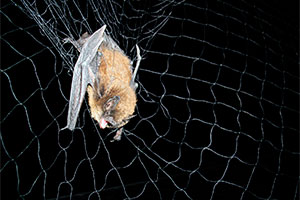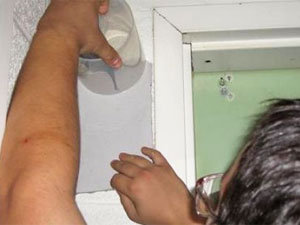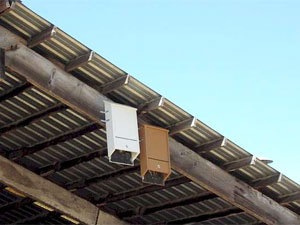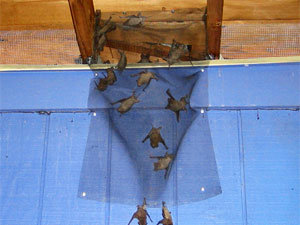To begin with, there is a whole bunch of reasons why people start thinking about ways of bats elimination. Most of them are very serious and deserve special attention.
Some specialists state that there is even an actual number of cases when diseases have been spread from these animals to humans.
To tell the truth, these are rare cases. Still catching them is of top importance.
What do we suggest:
- Find out about the ways to get animals fast and safely.
- Learn more about the pros and cons of traps.
- Get acquainted with the types of traps.
- Make sure you know how to use them.
5 Techniques on How to Catch a Bat in Your House
If you see that there is a bat in your house, isolate it in one section/room of your house and then close the door. Make sure that all family members and pets are out of that area. Then open the windows and allow the animal to escape. This is the easiest way, but in most cases it is useless.
This is why we suggest choosing one of the following techniques:
Use a butterfly net.
 This is a hard solution, especially when the creature’s really big. Of course, you can wait for it to land. While doing it, be very careful when closing the top of the net in order not to crush the bat. Bring it outside and release.
This is a hard solution, especially when the creature’s really big. Of course, you can wait for it to land. While doing it, be very careful when closing the top of the net in order not to crush the bat. Bring it outside and release.
At times a fishing net also works just fine for this purpose.Thick leather gloves.
 Do you have thick leather gloves? Then use them for bat protection. You won’t get bitten (animals are never aggressive till the time you start grabbing them. This is when they start defending).
Do you have thick leather gloves? Then use them for bat protection. You won’t get bitten (animals are never aggressive till the time you start grabbing them. This is when they start defending).Trap the creature.
 Trap the creature in a bowl, jar, or bucket and wait till the time it lands. Being exhausted it can be easily removed outside, just slide one piece of paper right between the jar and the wall. Bring the animal outside.
Trap the creature in a bowl, jar, or bucket and wait till the time it lands. Being exhausted it can be easily removed outside, just slide one piece of paper right between the jar and the wall. Bring the animal outside.Long-handled broom.
 Open the window as wide as it is possible. Get a long-handled broom and flick or shoo the bat out of the room right in the direction of the opening. It will fly out of the window.
Open the window as wide as it is possible. Get a long-handled broom and flick or shoo the bat out of the room right in the direction of the opening. It will fly out of the window.Blanket or towel.
 Smother the animal in a blanket or towel. Just drape it over the bat, bunch it up and bring outside to let go.
Smother the animal in a blanket or towel. Just drape it over the bat, bunch it up and bring outside to let go.
Be gentle as they have fragile bones. Don’t injure them.
After it has been successfully removed, inspect your house. Look for the holes that could serve as entry points. If you find any, promptly repair them for being certain that you will not have to face the same problem again.
How to Trap a Bat: Locating a Box or Net
Today there exists a number of solutions that are successfully adapted for trapping bats. Perhaps the main drawback is the fact they can’t be referred to as the most effective methods of extermination.

If you believe that there is a need to trap these animals, use special bat exclusion devices that help to catch them alive.
Most creatures live in colonies so it is better to use a repeater trap that allows flying into a cage without any possibility of getting out of it again.
How to locate a trap:
- A special cage or net must be placed over those points in the roof space that are used by the flying creatures to go in and out.
Normally the points are rather small. These can be loose roof tiles and holes the size of a coin.
- Place either one-way exit solutions or several traps for reduction of the cost and the time spent.
- Don’t use any baits, as there are no recognized products that may interest the bats, unless you manage to get enough insects and pests.
Why Choose Trap Bats
They say that traps are a nice way to get fully involved and see the animals close. However, many of us forget that handling any kind of wild creature can have dangerous consequences unless the person is vaccinated against rabies. Never handle them directly.
It can carry various diseases.
Trapping allows examining the animals visually, which is a rare chance. Besides, this is how one can identify the species settled in the area. It’s an opportunity to determine the presence of blue or red-listed species.
Types of Bat Traps
 It takes much time and effort to properly exclude bat from your house and attic. This is a special procedure that involves buying or making a cage, working on tall ladders and steep roofs, in awkward positions and dangerous surroundings.
It takes much time and effort to properly exclude bat from your house and attic. This is a special procedure that involves buying or making a cage, working on tall ladders and steep roofs, in awkward positions and dangerous surroundings.
If you hire a professional, the cost of the services can be more than you can afford. So, learning the rules of catching a bat on your own is of top necessity.
Today they differentiate two major types of traps:
- cage traps and boxes mounted on the exit points,
- glue board bat traps.
So, let’s start with the first one. Some people use modified cages and boxes and place them on the entry points, gathering the animals as they are coming out. The main drawback is the fact you have to cope with the creatures after you have trapped them. Killing them is illegal as they are protected species.
Every time you catch them and then release them somewhere outside your place they come back, so make sure you’ve sealed your house in the correct way. Don’t count on driving them long distances, as they always find their way back home. Bats usually find the roosts from as far away as nearly 500 miles. So after releasing make the so-called control job and close all the points.
Today’s market also offers many commercial traps: as soon as the creature enters a cage, the door closes on it. But as there is a minimum of 50 of them in a single colony, one should get many cages and reuse the majority of them till you trap all the animals.
What about glue board bat traps?
Don’t consider this way to be a perfect solution for extermination. Today many people choose glue boards. According to the instruction, they place them somewhere in the attic, where the animals are roosting. Only a very small percentage of them get really stuck, while others remain free. The stuck ones starve to death.
This is not only illegal, but also inhumane. However, this is only one of the sides of the problem. Later on, a very slow smelly process begins.
So, the main drawbacks of this method are the facts homeowners will have to use tens of glue boards to get all the bats out, and then they will need to do something with all the decaying bodies. Besides, no one knows what species the owners are dealing with: this is a serious case of interference with basic law regulations. This is mainly why we suggest choosing a more humane alternative.
Conclusion
 Now you know why trapping is so frequently addressed to. However, before following it, make sure you choose the right option (a non-glue one).
Now you know why trapping is so frequently addressed to. However, before following it, make sure you choose the right option (a non-glue one).
If there are only one or two bats that have accidentally entered your house, use one of the five techniques described above.
When you understand there is an infestation, use special cages or address a professional.
In any of the two variants stay careful and well-armed.

Disgraceful advice with the use of glue traps! – causing un necessary suffering and cruelty. Bats are protected species so you require a license to remove them from a property. This can be done with a simple one way tunnel where the bats can get out but cant get back in. this should only be done under license and in October when the bats have left
Well you live with bats until October in your attic. I have dogs and cats and children . I’m looking for one way funnels, but I can’t afford for myself, children and animals to get sick. Not mentioning the damage done by urine and feces.
Adorable idea! And this would be so funny at work because we’ve had some bats join us in the ofcfie recently. I have no idea how they get in, but it’s pretty funny!
I used some of this advice while I was capturing a bat in my apartment.
i am not only going to destroy them,but yeerrrrrr,they gonna suffer.
I am in Maine living for the next 4months in 5000 sq foot apt evert. Night we get one or more bats they are messing the ceiling tiles if I could catch them I would kill the little !!!!!!!!
Bats eat mosquitoes! You know…West Nile Virus and Zika Virus carriers?Idiots!
When I called animal control, not only did they not mention that it is illegal to kill bats, they sent the bat to a lab to be tested and killed. I live in Maryland. I feel so bad about doing that and that’s the reason I’m looking for other options.
Bats are protected in many states. Unless you enjoy harming animals; there is no reason to kill a bat. They don’t want to be in your house. They have mistakenly entered. These are great techniques that work. If you are too nervous just ask around and I am sure someone will be happy to save the little creature.
Bats are horrible creatures to have in your house. They are flying rats. Their urine and droppings cause thousands in damage and insurance does not cover bat damage. Call and ask any insurance agent. Bats carry fleas and ticks and often have rabies.
You can all sing and hold hands and talk about your great Bats are, but you’re just being naive.
I’m installing netting in my attic so that of Bats get in again they will get stuck in the net and starve to death.
You think the federal government is going to prosecute someone for killing Bats in their house? Ha ha. Go think again.